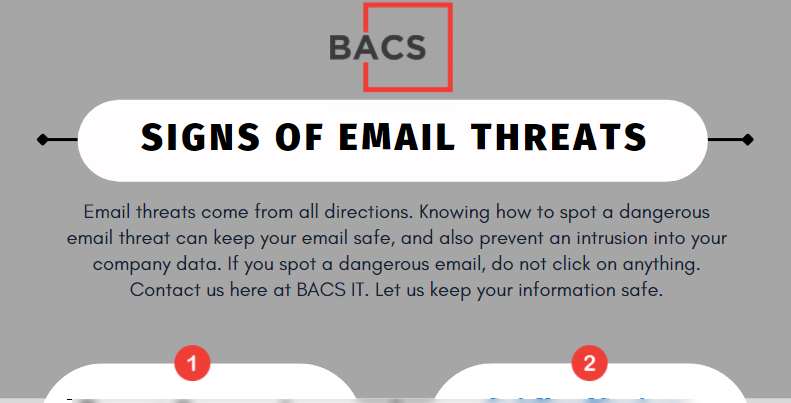Email is the most incredible communication medium ever created for personal and professional use. From the application’s humble beginnings in 1965, 270 billion emails are now delivered every day.
No other form of communication is as powerful and efficient as email.
It is challenging to nail down when the first email hack occurred. However, it is safe to say; attacks have been going on for much longer than documented. The first email account hacked may have occurred back in 1965 at MIT, when email was created.
Rise in Email Threats
Each year, email attacks continue to rise. Business and personal accounts are doorways to a much bigger payoff for the attacker. Statistics bear out the frightening surge in email threats.
- 96% of all cyber-attacks to your framework is by email
- According to the 2019 Verizon Data Breach report, 74% of all phishing scams come through email.
- 22% of all breaches involved phishing.
- Only 3% of users reported suspicious emails to authorities.
In the last few years, extraordinary times have changed the email threat landscape from passive attacks to highly aggressive intrusion teams. The bulk of infrastructure raids and widespread malware assaults come through unsuspecting email users.
Security gateways and software management designed for the Cloud has begun to stem the tide of low-level spam and bad link intrusions to email.


Phishing scams and malware attacks have shared characteristics:
- Unfamiliar Greeting
- Blatant spelling errors
- Threats to a “Sense of Urgency”
- Attachments
- Email addresses are inconsistent
Security agencies worldwide are bracing for more destructive Ransomware and DDoS attacks. Saudi Aramco suffered the most significant and destructive cyber-attack ever recorded. In a few short hours, over 35,000 computers were wiped out. The resulting cost to the company was well over $50 million.
User Apathy
Employees from some of the largest companies worldwide were surveyed on phishing and malware attacks, a staggering 48% of respondents saying, “it cannot happen to me.” User apathy has developed into a leading concern for every business.
The weakest link behind every keyboard is the end-user. Companies must start extensive user education. IT departments must provide the employee a stronger sense of involvement.
However, there will invariably be that one person who will click on anything.
It is imperative to identify the weakest link in a network before cyber-criminals find their entrance point. Once the attacker has infiltrated your company, they are now a user operating from within the network. Once inside, detection is virtually impossible.

Ransomware, Malicious Intent, DDos, and Email Threats
Ransomware and other malicious attacks have exploded since the beginning of the global pandemic. Years before, cyber-criminals were invading infrastructure targets with little to no fanfare. Now, the world is aware and playing catch-up.
Cyber-criminals only require one user’s email account for access to thousands of computer systems. Every industry is a target; pipeline infrastructure, healthcare, and the public sector are especially vulnerable.
New markets for cyber-criminals are opening up, such as the Cloud and, sadly, K-12 schools.
94% of all cyber-attacks originate from email!
How do Ransomware and malicious code happen? Any digital means can be used as an access point. USB drivers, social media, business attachments are all delivery vectors. Email remains the number one entry point for cyber-attack. Criminals prefer attachments first and links second.
Phishing attacks are addressed as fake delivery notifications or requests for software updates. The unsuspecting user clicks a link or attachment: a transparent download starts, and the attack begins.
Cyber-criminals have ungraded their encryption capabilities, using RSA 2048-bit private key encryption. This coding is impossible to break.
Do you know how to spot email threats? Check out our Signs of Email Threats You Need to Know!

Trends in Email Threats
Email remains the most effective means of communication for personal and work accounts. As long as electronic messaging remains popular, criminals will keep attacking.
Below are some of the developing trends for cyber-attack and their solutions:
-
- Google has taken a front seat in the security of business accounts and infectious phishing scams. Every day GMAIL is blocking over 100 million phishing emails; this is in addition to the 240 million COVID-related phishing scams. Google is taking a proactive approach to protecting its G-Suite business email accounts by continually updating code.
- Artificial Intelligence content interpretation is being applied to protect business and government interests. BEC Attacks (Business Email Compromise) tricks the user into paying for fraudulent invoices or subscriptions. At present, the technology is only applicable to English and German languages.
- New threats are coming down the line every day. Threadjacking is a unique approach that transforms an email thread mid-sentence and inserts the attacker’s comments. Attackers are scouring Outlook, Yahoo, and GMAIL for suitable threads for insertion. Since the email comes from a trusted party, attackers can deceive users into downloading the malicious code. Threadjacking has been applied extensively in ATT and Verizon mobile systems. The code is layered and hard to defend.
- Excel has been used for years as a means to embed malicious code into attachments. The attachment downloads a legitimate tool such as NetSupport Manager, which cyber-attackers use to manipulate a machine.
- Keyloggers are attached to an Excel file, helping attackers to log in to bank accounts.

Top 5: Dangerous Ransomware and Malware Code
Each of the following malware or ransomware programs has endless varieties. Cyber-criminals use malicious software to compromise email accounts. If a portion of code is not working on the target, the prepared cyber-attacker builds on that knowledge. Their team re-codes the application, making it more destructive and intrusive, then waits for the right opportunity.
- Social Engineering is one of the more recent additions to a well-rounded cyber-attack. This code is described as research and persuasion for the basis of spam and phishing scams spread by email. Attackers rely on the victim’s trust to steal data. Verizon’s Data Breach report says about 22% of intrusions involve social engineering and spoofing.
Most of the Fraud comes from attackers impersonating companies such as Microsoft, Apple, and Netflix. The FBI recorded over 25,00 incidents costing companies approximately $300 million.
- Spam has been linked with email since the beginning. Spam is usually email advertising the next best thing in unwanted products or services. Statista reports that 60% of the world’s internet traffic is made up of spam. The most annoying and costly spam effect is the messages that choke email inboxes, culminating in lost time and productivity.
Another costly complication of spam, messages often carry malware code.
- Ransomware and Trojans are the most recognizable malicious code of this group. Ransomware and trojans are examples of malicious malware code buried in emails. Verizon’s report again says of all the data breaches, 17% are the malware type, and of this group, 27% are vicious ransomware. Ransomware uses advanced encryption to block files and then demand payment. Attackers usually want payment in the form of cryptocurrency.
Trojans are another dangerous malware code that gets into a system by hacking logins. Nomoreransom.org is an organization that is fighting aggressive ransomware code.
- DDoS and Botnets are alternative forms of malicious code. Botnets are a group of systems linked to the internet and controlled by a hacker. DDoS (Distributed Denial of Service) is code that enters a machine by email and inundates the system with spam or phishing code. These types of codes will send thousands of emails in a brief period. The objective is to overwhelm the system so hackers can penetrate a network unnoticed.
- Spear Phishing and Phishing use fraudulent emails to steal money from a company and personal bank accounts. In 2019 the FBI reported losses tolling $57 million from 119000 vicious attacks. Attackers will conduct a comprehensive analysis of their targets to make the scams more efficient.
An extensive report from Europol provides more frightening statistics on the widespread use of phishing. 65% of all the hacker groups worldwide use some form of phishing. In the shadowy world of espionage, 78% of these incidents have email phishing techniques.
Today’s cyber-criminals have access to a vast spectrum of malicious code, causing billions in lost money and productivity. New tendencies of these criminals are using social engineering on millions of unsuspecting users.
Industry experts have agreed one of the fastest ways to combat the rising threats is by employee education.
Solutions Stem from an Increase in Email Threat Intelligence
What is the answer to email security? For years, the same question has been given to so-called experts, and their same answer repeatedly is to educate the user. In our post, this statistic from above says it all: a staggering 48% of respondents saying, “it cannot happen to me.”
The brightest minds in the world have been working on different solutions. Protection must start before malware hits the email inbox and eliminate the user altogether
Two Technologies that may provide answers:
- Email Gateways
- Endpoint Security
Email Gateways Powered By Artificial Intelligence
Email gateways can be deployed as a Cloud or on-premise solution. Each email that comes through a business system is classified and will catch both known and unknown threats. Advanced machine learning and AI are used to classify emails and block malicious messages with ransomware payloads.
The email gateway is a type of server where every email passes through and is analyzed for malicious code. Secure gateways allow businesses to control email before it hits the inbox. AI-powered gateways scan the email URL for suspicious delivery sites. Content is scanned, and any email deemed suspicious is taken out of the system and placed in a sandbox.
Various protective systems around the internet are getting involved. Granular email filtering is used to tag suspicious emails for later examination. The systems are designed to block various emails, including payment redirects and fraudulent vendor invoicing.
One of the strongest companies in the field of Email Gateways is Proofpoint.
Proofpoint
Proofpoint offers a complete lineup of products for email protection, Advanced email threat protection, to Cloud Security. Compliance is another string point for the company. They offer solutions to meet regulatory and corporate requirements while managing cost and complexity.
Endpoint Security
Managing Endpoints on the network has been in the crosshairs of developers for years. Threats come from every angle, which includes smartphones, tablets, watches, or any digital device. The approach is to protect every device by having a level of security.
Over several years, Endpoint security has evolved from the antivirus space to now include malware detection. Network administrators have complete control of what goes out and what comes into the network. Each connected device is controlled. If the device does not meet the requirements, it is not allowed access. Some administrators will only allow cursory access.
No other company has the resources to control endpoints more than Cisco.
Cisco
Cisco, the worldwide expert on connected devices, is reinventing what can be connected to global networks. The company is directing its efforts to Endpoint and Detection systems. Cisco has become heavily involved with Behavior-based detection and advanced machine learning models.
Cisco has been working steadily in the area of work-from-home safety solutions. The aim is to protect home users and their networks.
Cisco Solutions:
- Hybrid Workforce to manage distributed devices from a central location.
- Multi-Cloud solutions are designed for simpler access anywhere in the world.
- Hybrid Workspaces are designed for automated connectivity and intelligent infrastructure.
Cutting Edge
The cutting edge of cyber-security and email changes daily. Tactics used by attackers shift from one attack point to the next instantaneously. Networks are under constant siege. Fresh approaches to cyber security are needed to transform the landscape.
Cutting-edge technologies are making cyber defenses stronger than ever before. Industry leaders have developed three cyber-security directives any company or governmental agency can follow.
Policy First
Companies must establish a sound policy or best practice, employees must follow. Without this direction, a worker can end up in treacherous waters. Leaders must put down clear directions on employee cyber hygiene.
Policies must include how to handle incoming emails and what type of email is acceptable to send. Leaders must understand “Network Users are Securities Weakest Link.”
Behavior Analysis
With proper endpoint security, administrators can measure a companies’ network. The benefits tell how the network operates on a normal basis and detects any abnormal behaviors. The approach goes beyond traditional procedures and can detect ransomware and malicious code with no prior digital signature.
With the proper monitoring, anomalous activities can be stopped, and infected devices can be removed.
Embrace Technology
Transformative technologies are continually coming online. Less human intervention is needed by machine learning systems that automatically learn from past experiences. Dramatic results in cost savings and improved productivity are seen.
Game-changing technologies such as EDR (endpoint detection and response) can monitor servers, mobile devices, and home computers in real-time. Any suspicious behavior is detected instantaneously, and actions against the threats are immediate.
BACS IT Can Help with Email Threats, IT Threats, and IT Solutions
Companies, government agencies, and individuals must learn to embrace the new technologies that will inevitably be coming into focus. The brightest minds in the world have spent careers devoted to defeating the massive flood of cyber-attacks.
To find out how to ensure the safety of your emails, contact us here at BACS IT. We are IT consultants in the Bay Area ready to help keep your business, your employees, and your data safe from email threats and more. When it comes to advanced threat protection for email accounts, BACS IT has you covered.









